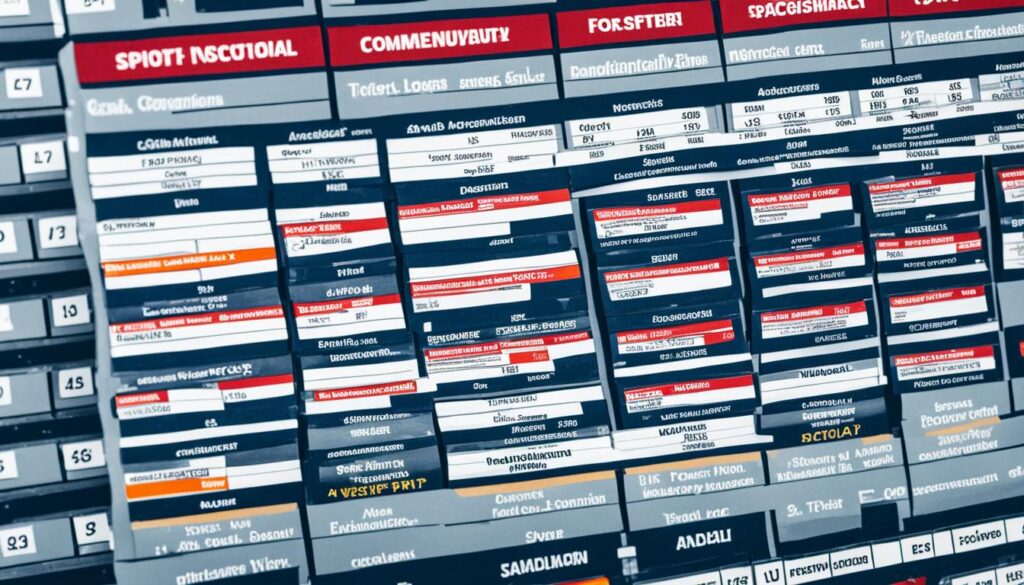Hey there, fellow tennis enthusiasts! Whether you’re a complete newbie or someone looking to brush up on the basics, I’m thrilled to present to you a comprehensive beginner’s guide to tennis.
As a passionate tennis player myself, I know the excitement and joy that this sport brings. So, let’s dive right in and unlock the world of tennis together!
How is tennis played?
When you step onto a tennis court, the objective is simple: hit the ball over the net and keep it in play.
The scoring system may seem a bit perplexing at first, but don’t worry, we’ll break it down for you. Plus, we’ll explore the thrilling singles matches and the dynamic doubles format, where teamwork is key.
And of course, we can’t forget to familiarize ourselves with the court’s dimensions and features.
The Basic Rules of Tennis
To fully enjoy and engage in a fair game of tennis, it’s essential to understand the rules that govern the sport.
Let’s dive into the fundamental rules and concepts that will lay the foundation for your tennis journey. The full version of the rules can be found at the International Tennis Federation website (ITF).
Deciphering the Boundaries and Lines
A tennis court may appear intimidating at first glance, but fear not!
The boundaries and lines have a specific purpose. The court is divided into two halves by a net, and each half is further divided into service boxes, singles sidelines, and baselines.
Understanding these lines will help you determine whether a shot is in or out during a game.
Mastering the Art of Serving
Serving is the initial shot that starts a point in tennis. It’s your opportunity to gain an advantage and dictate the pace of the game.
As a server, you must stand behind the baseline and alternate serving from right to left, beginning from the right side of the court.
Serving involves hitting the ball diagonally across the net into the opponent’s service box, aiming for accuracy and power.
Differentiating Legal and Illegal Shots
In tennis, certain shots are considered legal, while others are not permitted. Legal shots involve hitting the ball before it bounces twice on your side of the court and ensuring it clears the net and lands within the boundaries.
Illegal shots include hitting the ball out of bounds or failing to clear the net on your side.
It’s important to practice proper technique to execute legal shots consistently.
Fault Calls and Let Serves
During the serve, if the ball fails to land in the opponent’s service box or hits the net and doesn’t go over, it results in a fault.
Two consecutive faults result in a double fault, causing the server to lose the point.
However, if the ball hits the net during a serve but still lands in the correct service box, it’s considered a let serve, and the server gets another opportunity to serve without penalty.
Understanding “Deuce” and “Advantage”
Ah, the mysterious terms of “deuce” and “advantage.” In tennis, when the game reaches a tie at 40-40, it’s called “deuce.”
At deuce, a player must win two consecutive points to secure the game. When a player wins one point after deuce, they gain the advantage. If they win the next point, they win the game.
However, if they lose the point, the game returns to deuce, and the battle for two consecutive points continues.
By understanding the boundaries, lines, serving rules, legal and illegal shots, fault calls, and the deuce-advantage concept, you’ll be equipped with the knowledge to play tennis fairly and navigate through matches confidently.
Keep these rules in mind as you progress in your tennis journey, and remember, practice and experience will further deepen your understanding of the game.
Essential Equipment for Tennis
To fully immerse yourself in the world of tennis, it’s important to have the right equipment that suits your game style and enhances your performance. Here are some practical tips to consider when selecting your tennis gear:
- Choosing the Perfect Tennis Racket:
- Grip Size: Opt for a racket with a grip size that feels comfortable and allows you to maintain a secure hold on the racket handle.
- Head Size: Beginners often benefit from a larger head size (between 100-110 square inches) as it provides a larger sweet spot and more forgiveness on off-center hits.
- Weight and Balance: Consider the weight and balance of the racket. Lighter rackets are more maneuverable, while heavier ones offer more stability and power.
- Demo Rackets: If possible, try out different rackets before making a purchase. Many tennis stores provide demo rackets for testing, allowing you to get a feel for different models.
- Understanding Tennis Balls:
- Felt Type: Tennis balls come in different types of felt, such as regular duty and extra duty. Regular duty balls are suitable for clay or indoor courts, while extra duty balls are designed for hard courts.
- Pressure: Tennis balls lose pressure over time, affecting their bounce. For recreational play, regular pressure balls are suitable, but for competitive matches, opt for fresh, high-pressure balls for consistent performance.
- Ball Quality: Choose tennis balls from reputable brands to ensure durability and a consistent feel during play.
- Importance of Proper Footwear:
- Tennis-specific Shoes: Invest in a pair of tennis shoes that provide stability, support, and traction on the court. Tennis shoes have specialized features to handle the lateral movements and quick direction changes required in the game.
- Fit and Comfort: Ensure that your tennis shoes fit properly, allowing enough room for your toes while providing a snug fit around the heel. Comfort is essential to prevent discomfort and blisters during extended play.
- Tennis Clothing:
- Breathable Fabric: Choose clothing made from moisture-wicking materials that keep you cool and comfortable on the court. Look for fabrics that offer breathability and allow for unrestricted movement.
- Fit and Mobility: Opt for clothing that allows freedom of movement and doesn’t restrict your strokes or footwork. Consider the weather conditions and choose appropriate layers for warmth or sun protection.
Remember, your tennis gear is an investment in your enjoyment and performance on the court. Take the time to try out different rackets, select the right tennis balls, invest in suitable footwear, and choose comfortable clothing.
As you grow in your tennis journey, you may fine-tune your equipment preferences to suit your evolving playing style and needs.
Enjoy the process of finding the perfect gear and get ready to unleash your full potential on the tennis court!
Exploring Singles and Doubles Tennis
Tennis is a versatile sport that allows you to choose between playing singles or doubles. Each format offers its own unique experience and challenges.
Let’s dive into the world of singles and doubles tennis, understanding the dynamics and strategies involved.
Singles Tennis: Conquer the Court Alone
In singles tennis, the entire court is yours to conquer. It’s a thrilling experience where you rely solely on your own skills and tactics to outplay your opponent.
Here are some key aspects to consider when playing singles:
- Court Coverage: With the entire court at your disposal, it’s essential to develop strong footwork and agility. Efficiently moving around the court will allow you to reach the ball and set up your shots effectively.
- Strategy and Positioning: Analyzing your opponent’s strengths and weaknesses is crucial in singles. You can strategically position yourself to exploit their vulnerabilities while utilizing your own strengths. Adapt your game plan as the match progresses to stay one step ahead.
- Shot Selection: In singles, shot variety and consistency are vital. You need to master different shots like powerful forehands, reliable backhands, accurate volleys, and well-executed serves. Utilize a mix of shots to keep your opponent guessing and create opportunities to win points.
Singles tennis is a bit as snooker; H2H – one of the players have to win. The match can’t finish without a winner and a loser.
Doubles Tennis: Teamwork Makes the Dream Work
Doubles tennis adds an exciting element of teamwork and coordination to the game. Playing with a partner requires effective communication and synchronization.
Here’s what you need to know about doubles tennis:
- Court Positioning: Doubles court positioning is crucial to cover the court efficiently as a team. Typically, players adopt either an “up and back” formation or a “side-by-side” formation. Communication and understanding with your partner are key to maintaining the right positions during the game.
- Communication: Constant communication with your partner is essential in doubles tennis. Effective communication allows you to coordinate strategies, plan your shots, and avoid collisions on the court. Use hand signals or predetermined signs to communicate swiftly and efficiently during a match.
- Teamwork and Coordination: Doubles tennis is all about synergy. Work together with your partner to set up plays, create openings, and put pressure on your opponents. Cover each other’s weaknesses and capitalize on each other’s strengths to dominate the game.
- Net Play: In doubles, players often employ more aggressive net play to take control of the point. Mastering volleys, smashes, and effective net positioning can help you dominate the net and put your team in a commanding position.
Remember, both singles and doubles have their own unique appeal. Singles allows you to showcase your individual skills and strategy, while doubles emphasizes teamwork and coordination.
Whether you prefer the intensity of singles or the camaraderie of doubles, embracing both formats will enhance your overall tennis experience.
Scoring in Tennis
Scoring in tennis is a bit like an adventure! Imagine each game as a puzzle made up of smaller parts called points. Your goal is to collect four points to win the game. But here’s the fun part: the points have special names!
At the beginning of the game, we start with “Love.” It’s like having zero points, and both players begin with “Love” on the scoreboard.
Now, let’s start earning points! The first point you win is called “15.” Great job! If you win another point, you get “30.” Keep going! And if you win one more point, you reach “40.” Woohoo! The scoring goes like this: Love, 15, 30, 40.
But here’s where things get really interesting. If both players reach 40 points, it’s called “Deuce.” It’s like a tiebreaker situation. To win the game from Deuce, you need to be a real champion and win two points in a row. It’s not easy, but it’s exciting!
Let’s say you’re at Deuce and you win the next point. You get a special advantage called “Advantage.” It means you’re a step ahead of your opponent. If you win the next point after “Advantage,” congratulations, you’ve won the game! But if you lose that point, it goes back to Deuce, and the thrilling battle for two consecutive points continues.
To win the entire match, you need to win a specific number of games. Usually, it’s either the best of three sets or the best of five sets, depending on the match. Each set is a collection of games, and each game is made up of points.
To sum it up: Scoring starts with Love, then progresses to 15, 30, and 40. When both players reach 40, it’s Deuce, and you need two consecutive points to win the game. If you win the required number of games, you win the set, and if you win the required number of sets, you become the match champion!
With a little practice and a lot of excitement, you’ll become a pro at scoring in tennis! So grab your racket, embrace the challenge, and enjoy the thrill of the game!
Sets and Tiebreaks: Unleashing the Excitement!
In tennis, a match is usually made up of sets, which are like chapters in a thrilling story. Each set is a collection of games, and the goal is to win a certain number of sets to emerge victorious. But what happens when a set is tied? That’s when the tiebreak comes into play!
Sets: Chapters of the Tennis Match
Imagine a tennis match as a book with different chapters called sets. To win a set, you usually need to win six games, but there’s a catch! You need to win by a margin of at least two games. For example, if you’re leading 6-4, you’ve won the set because you have a two-game advantage.
But what if the set is tied at 6 games each? That’s when things get really exciting because it’s time for a tiebreak!
Tiebreak: The Thrilling Showdown
A tiebreak is like a mini-game within a set, designed to determine the winner of the set when the score is tied at 6 games each. It adds an extra dose of excitement and suspense to the match. Let’s see how it works:
- The tiebreak starts with a player serving the first point. After that, the players take turns serving two points each. The first server usually serves one point, and then it alternates between the players. The serving order continues until the tiebreak is over.
- The scoring in a tiebreak is a little different. Instead of using the regular points system (Love, 15, 30, 40), it’s simpler. Each point is counted as 1, 2, 3, and so on.
- The first player to reach seven points, with a margin of at least two points, wins the tiebreak and, ultimately, the set. For example, if the score is 7-5 or 8-6, the tiebreak is over, and the player with seven or more points, with a two-point advantage, emerges as the winner.
- If the tiebreak reaches a score of 6-6, the tiebreak continues until a player has a two-point lead. This means the tiebreak can go on for a while, adding even more excitement to the match!
Remember, the tiebreak only determines the winner of a set. If there are multiple sets in a match, the players continue playing until one of them wins the required number of sets to win the entire match.
So, sets and tiebreaks add layers of suspense and drama to the game of tennis. Each set is like a chapter in the match, and when a set is tied, the tiebreak determines the winner of that set. With this knowledge, you’re ready to follow the thrilling ups and downs of a tennis match. Get ready to enjoy the rollercoaster ride of sets and tiebreaks!
Other things that are good to know about tennis
Here’s some extra topics for you who would like to learn the game of tennis!
Mastering Tennis Shots: Unleash Your Inner Champion
To become a formidable tennis player, it’s crucial to master various shots that make up the essence of the game. We’ll dive into the world of groundstrokes, volleys, lobs, and overhead smashes, providing you with insights and techniques to perfect each stroke.
Additionally, we’ll introduce you to specialty shots that can add finesse and creativity to your game, allowing you to emulate the brilliance of tennis legends like Federer and Serena.
Developing Tennis Skills: Building the Foundation of Excellence
Tennis is not just about hitting the ball; it’s about moving gracefully and efficiently on the court. We’ll delve into the importance of footwork, agility, and quick reflexes, which form the backbone of your game.
Through a series of training exercises, we’ll help you improve your speed, control, and overall athleticism.
Together, we’ll work on building consistency, power, and finesse in your shots, setting the stage for your journey towards mastery.
Tennis Strategies and Tactics: Outsmarting Your Opponents
As you gain confidence and skill, understanding the strategic side of tennis becomes paramount. We’ll unveil offensive and defensive strategies that can give you the upper hand in matches.
Learn how to position yourself strategically on the court to exploit your opponent’s weaknesses while maximizing your own strengths. We’ll guide you in selecting the right shots for different situations, ensuring you make sound decisions and keep your opponents on their toes.
With these tactics in your arsenal, victory will be within reach.
Finding the Perfect Tennis Coach or Instructor: The Key to Elevating Your Game
Taking your tennis game to the next level often requires the guidance of a knowledgeable coach or instructor. We’ll explore the invaluable role that a tennis coach plays in your skill development journey.
Discover tips and insights on choosing the right coach who can understand your needs, provide personalized instruction, and help you reach your full potential.
Furthermore, we’ll highlight the benefits of engaging in group lessons and practice sessions, where you can learn from fellow enthusiasts, forge friendships, and share the joys of the sport.
Preventing Common Tennis Injuries: Safeguarding Your Well-Being
Just like any physical activity, tennis carries the risk of injuries. However, with proper precautions, you can minimize these risks and keep yourself in top form.
We’ll discuss common tennis-related injuries, their causes, and most importantly, how to prevent them. Explore warm-up routines tailored to tennis, engage in stretching exercises that target key muscle groups, and understand the importance of maintaining proper technique and allowing ample rest for recovery.
By prioritizing your well-being and implementing injury prevention strategies, you’ll not only prolong your time on the court but also derive greater enjoyment from the game you love.
Conclusion & FAQs
Congratulations on completing our comprehensive beginner’s guide to tennis! We hope this journey has provided you with a solid foundation to start your tennis adventure.
Remember, tennis is not just a sport; it’s a beautiful blend of skill, strategy, and passion. So grab your racket, find a court, and let the love for tennis ignite within you. Practice, persevere, and embrace the joy of the game.
See you on the courts!
Selecting the right tennis racket depends on factors such as your skill level, playing style, and personal preferences. Consider factors like racket head size, weight, balance, and grip size. It’s best to try out different rackets and seek guidance from a knowledgeable tennis professional to find the perfect fit.
Tennis offers a variety of shots, including forehand, backhand, volleys, lobs, overhead smashes, drop shots, and slices. Each shot has its own technique and purpose, allowing players to adapt to different game situations. Practice and coaching can help you develop proficiency in executing these shots effectively.
Footwork and agility are essential for efficient movement and quick reactions on the tennis court. Regular practice of footwork drills, ladder exercises, and agility training can help improve your speed, balance, and court coverage. Additionally, working on your overall fitness level through cardio and strength training can contribute to enhanced performance on the court.
Tennis strategies vary depending on the situation, opponent, and playing style. Common tactics include hitting deep to keep your opponent on the move, using angles to create openings, approaching the net to put pressure on your opponent, and mixing up your shots to keep them guessing. Learning to read your opponent’s weaknesses and adapting your game plan accordingly is crucial.
To prevent common tennis injuries, it’s important to warm up properly before playing, including stretching exercises for the whole body. Focus on strengthening the muscles used in tennis, particularly the core, legs, and shoulders. Additionally, practicing proper technique, using appropriate footwear, taking breaks, and listening to your body can all help reduce the risk of injuries on the court.
Good luck with your tennis!
As a tennis player myself, I can attest to the thrill and fulfillment that this sport brings. I hope that this personal guide has ignited your curiosity and given you the confidence to dive into the wonderful world of tennis.
Remember, every great player started as a beginner, and with dedication and practice, you can achieve greatness too. So, get out there, enjoy the game, and let the courts become your second home.
Game, set, match!
- This Many Calories Are BURNED (per Hour) in Different Sports/Activities [List/Table]

- Data-Driven Success: Leveraging Analytics Tools in Sports Marketing

- Monitoring Triumph: The Importance of Ad Tracking in Sports Advertising

- Strategic Impact: Thoughtful Ad Placement in Sports Marketing

- Maximizing Space: Navigating Ad Inventory in Sports Media Planning

- Activating Success: The Role of Activation in Sports Marketing
